
SYNC WINES California
Concept Development:
Noel David Carson, Tim Ahearn, Todd Deutsch, Susan Grant & Christina Mulka
Creative Direction:
Noel David Carson
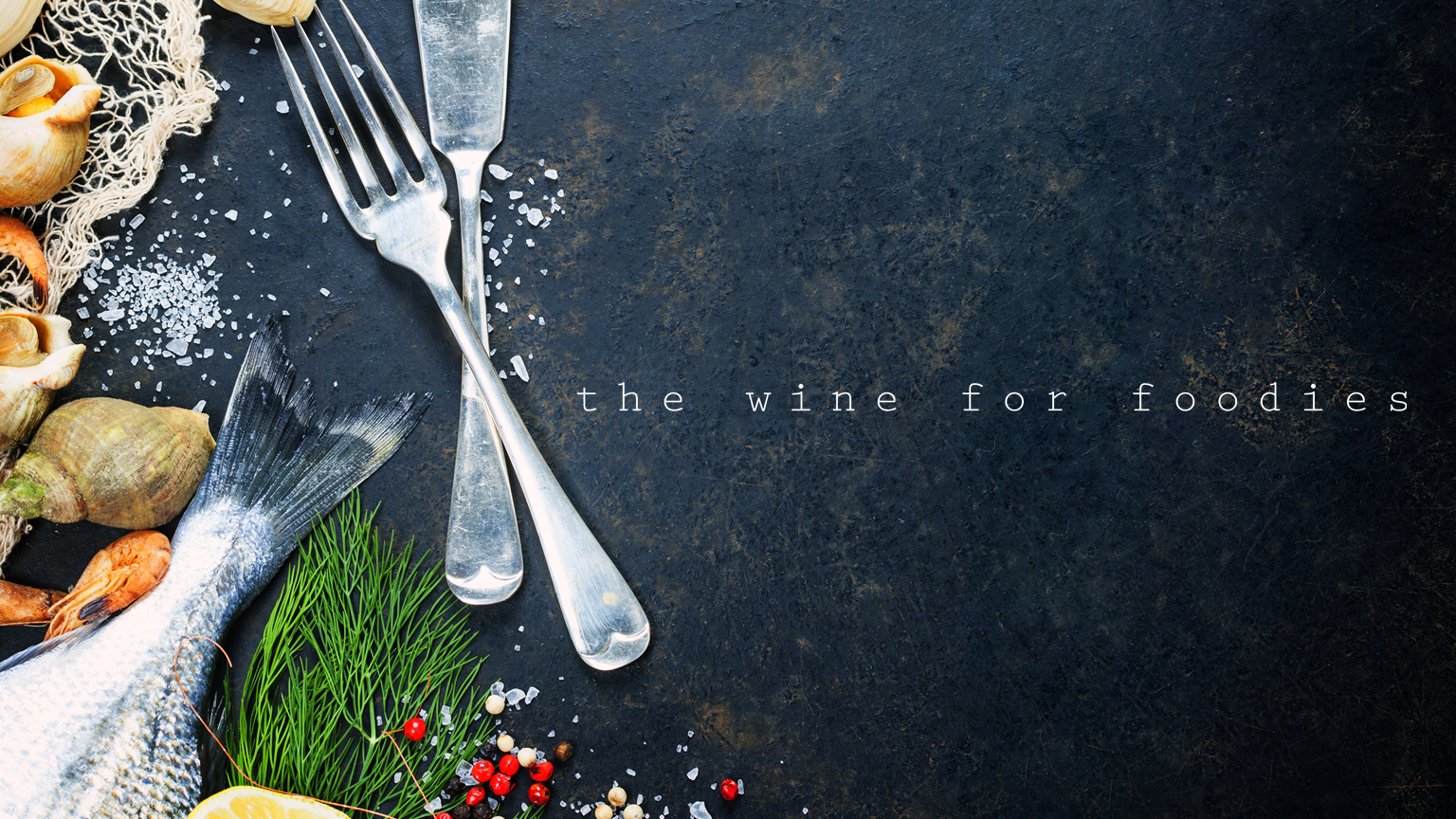
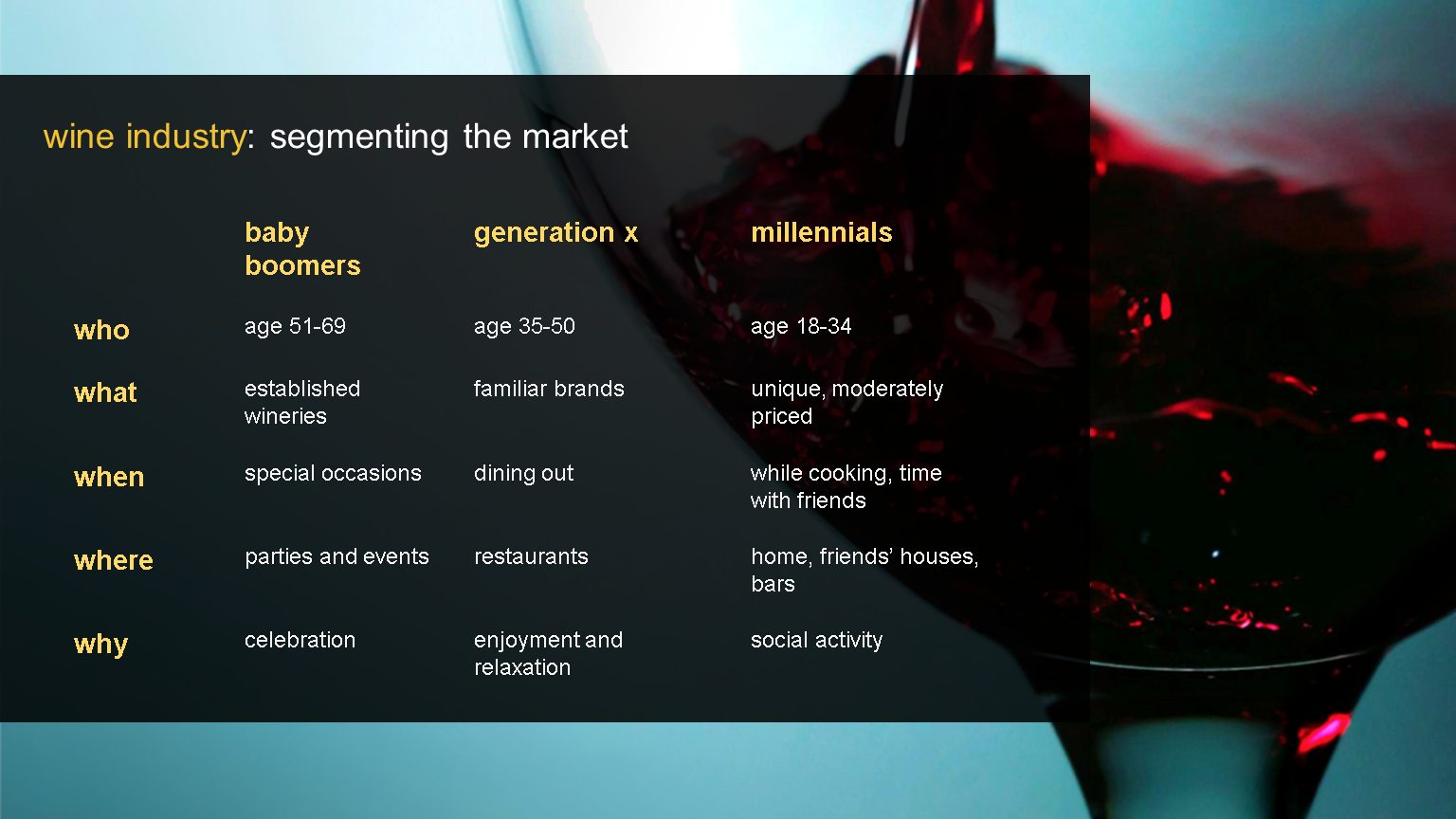
Wine Industry: Segmenting the Market
Wine consumption and behaviors vary greatly by generation. Although Baby Boomers still make up the largest demographic of wine consumption, Millennials are the growing second and continue to grow faster than any other group. Additionally, wine consumption overall has grown for more than 20 consecutive years, making development of a wine brand targeted at Millennials a profitable opportunity. First, it is important to understand the differences in consumer behavior amongst generations so that we can best reach our target.
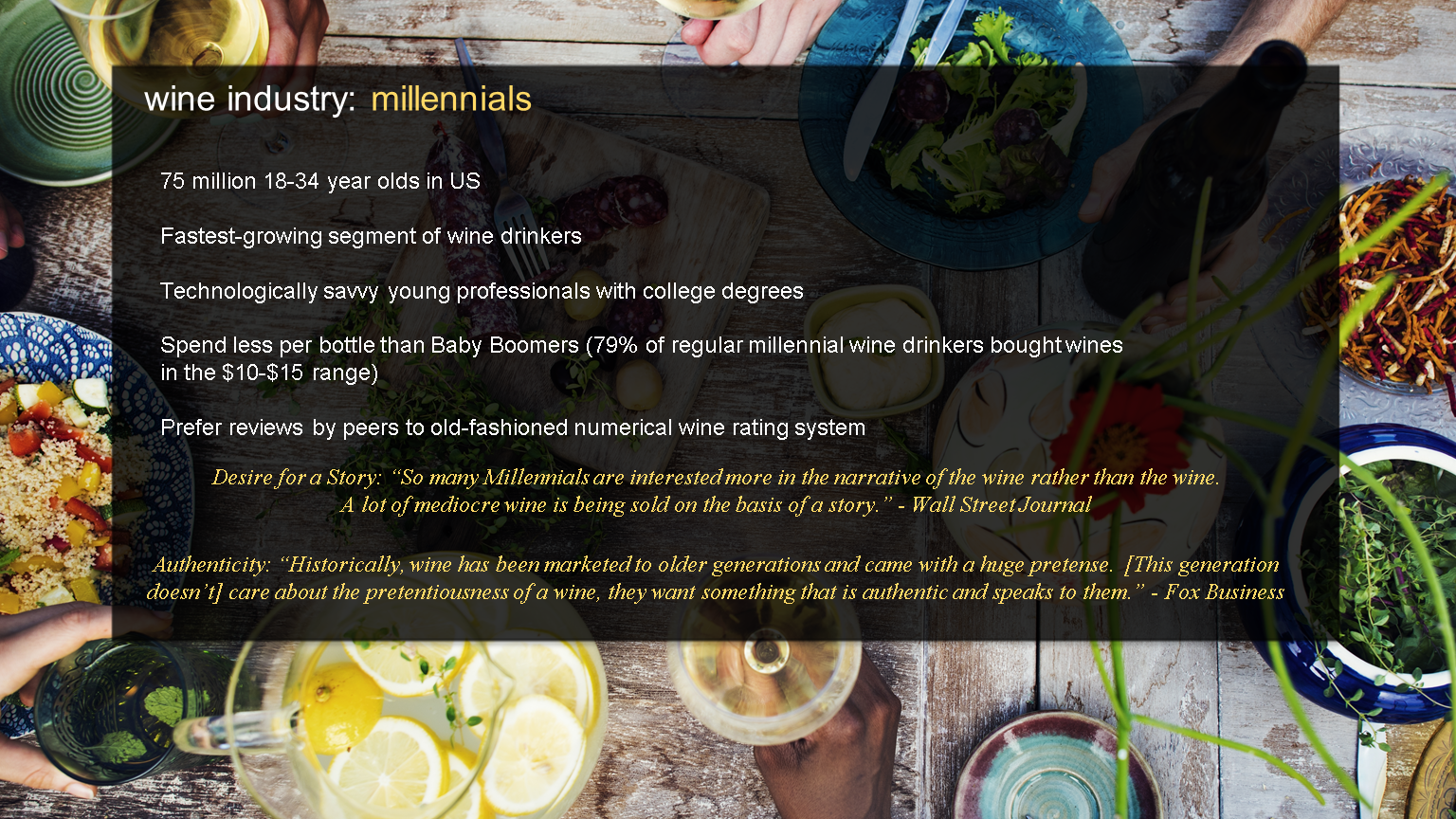
Wine Industry: Millennials
There are 75 million millennials - people between the ages of 18 and 34 - in the United States (Teague). In the wine industry, Millennials are widely seen as the fastest growing segment of wine drinkers (Stanford). As such, they are changing the way Americans consume wine. Typically technologically savvy young professionals with college degrees (About), Millennial wine drinkers are very interested in the backstory of their wines and are influenced by the reviews of their peers online and in person. As Jason Jacobeit, the 29-year-old head sommelier of Batard restaurant in New York put it: “So many Millennials are interested more in the narrative of the wine, rather than the wine. A lot of mediocre wine is being sold on the basis of a story” (Teague).
According to a recent study, Millennials spend less per bottle on wine than Baby Boomers - 79% of regular Millennial wine drinkers bought wines in the $10-$15 range (Teague). This may be in accordance with the democratization of wine. Millennials do not see wine as the drink of choice for a pretentious upper class, rather, they see it as a potentially affordable accompaniment to a good meal.
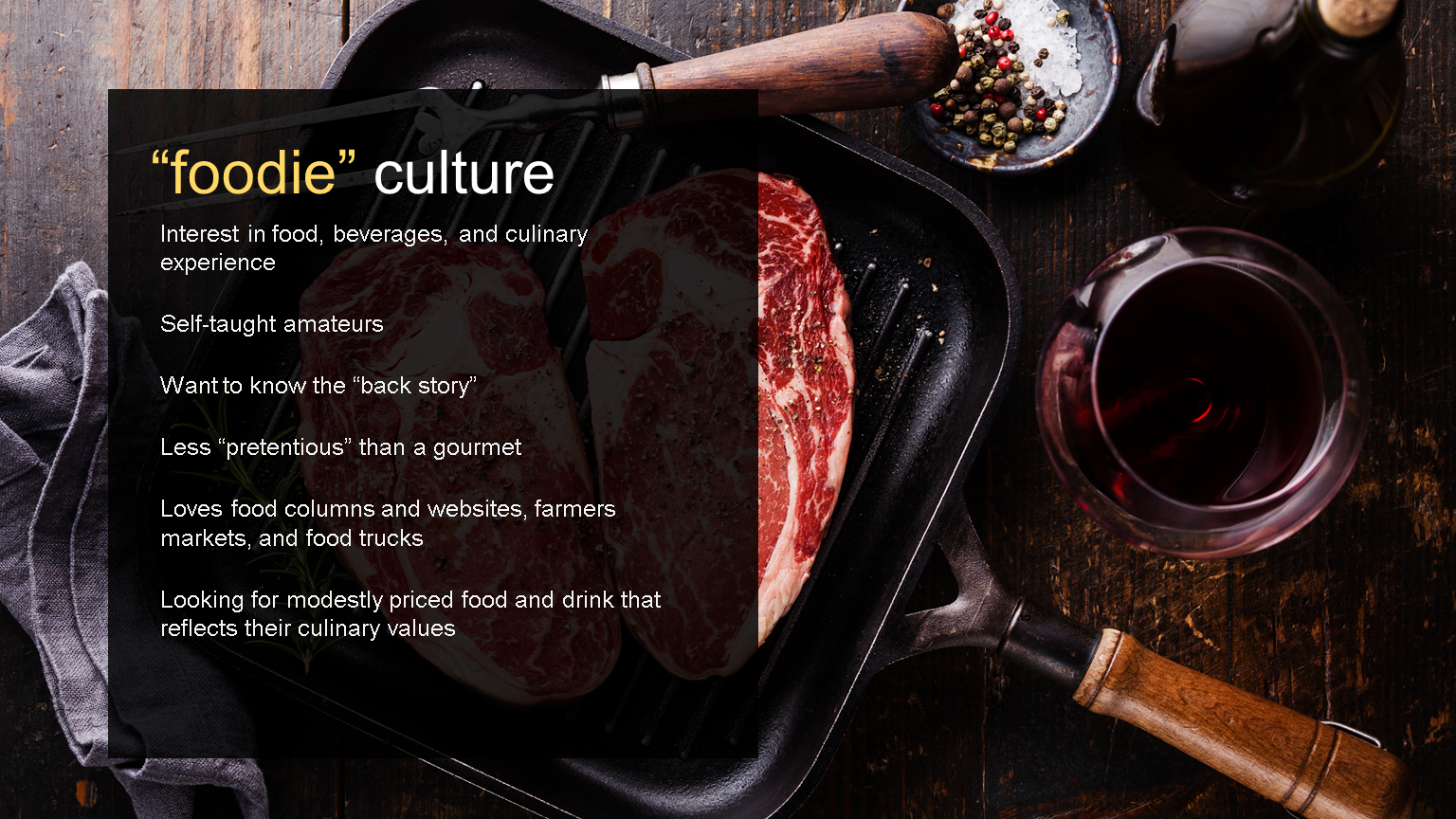
“Foodie” Culture
The term “foodie” was coined in the early 1980s in the United States. The hobby has given rise to the popularity of farmers’ markets, food columns and websites, and entertainment media such as the Food Network. A “foodie” is described as someone that has a deep interest in food, alcoholic beverages, and culinary experiences.
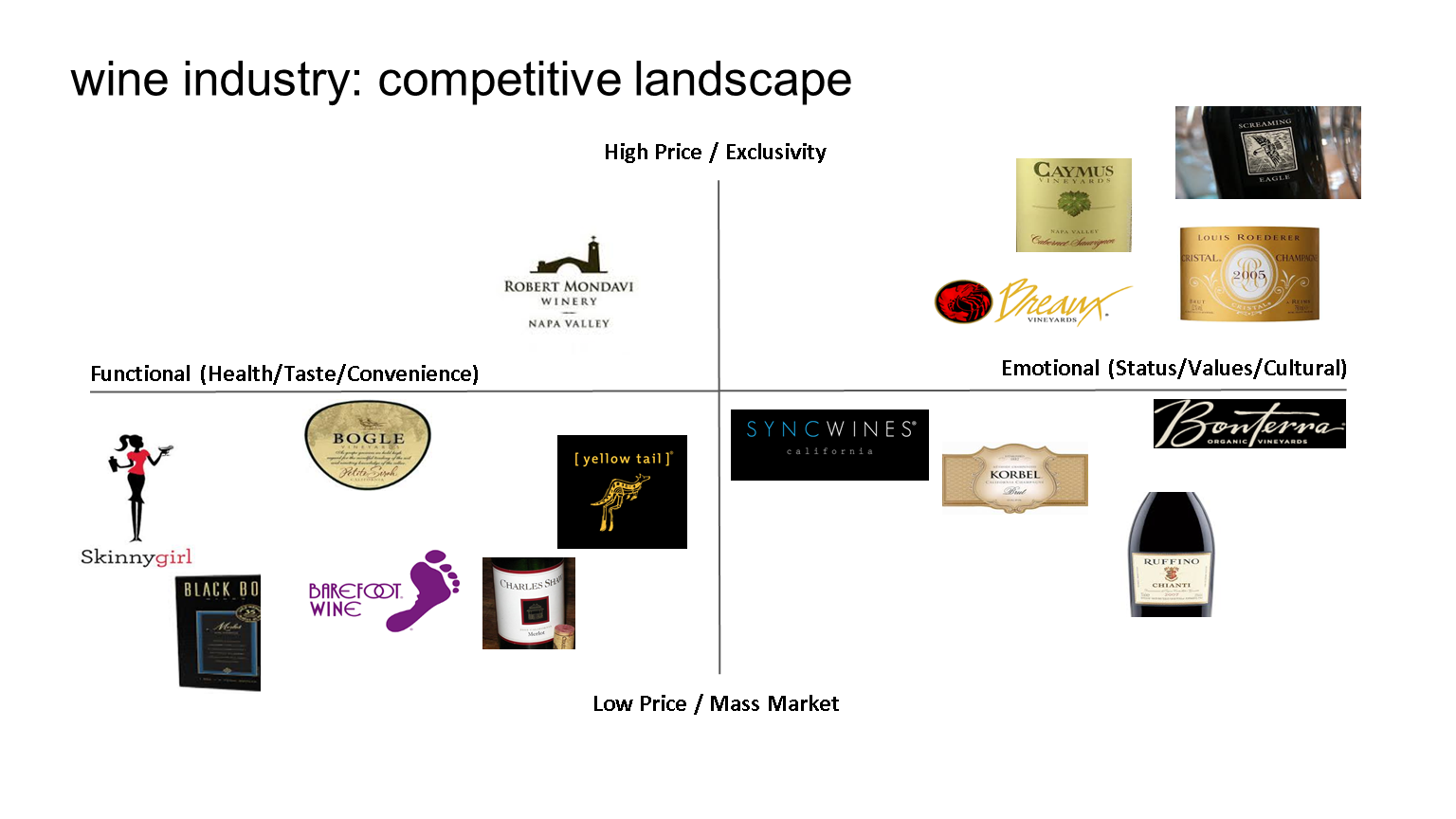
Wine Industry: Competitive Landscape
The wine industry market tends to be first driven by vertical differentiation (Price), and then by various forms of horizontal differentiation which is highly variable, but can be clearly separated by various functional and emotional categories.
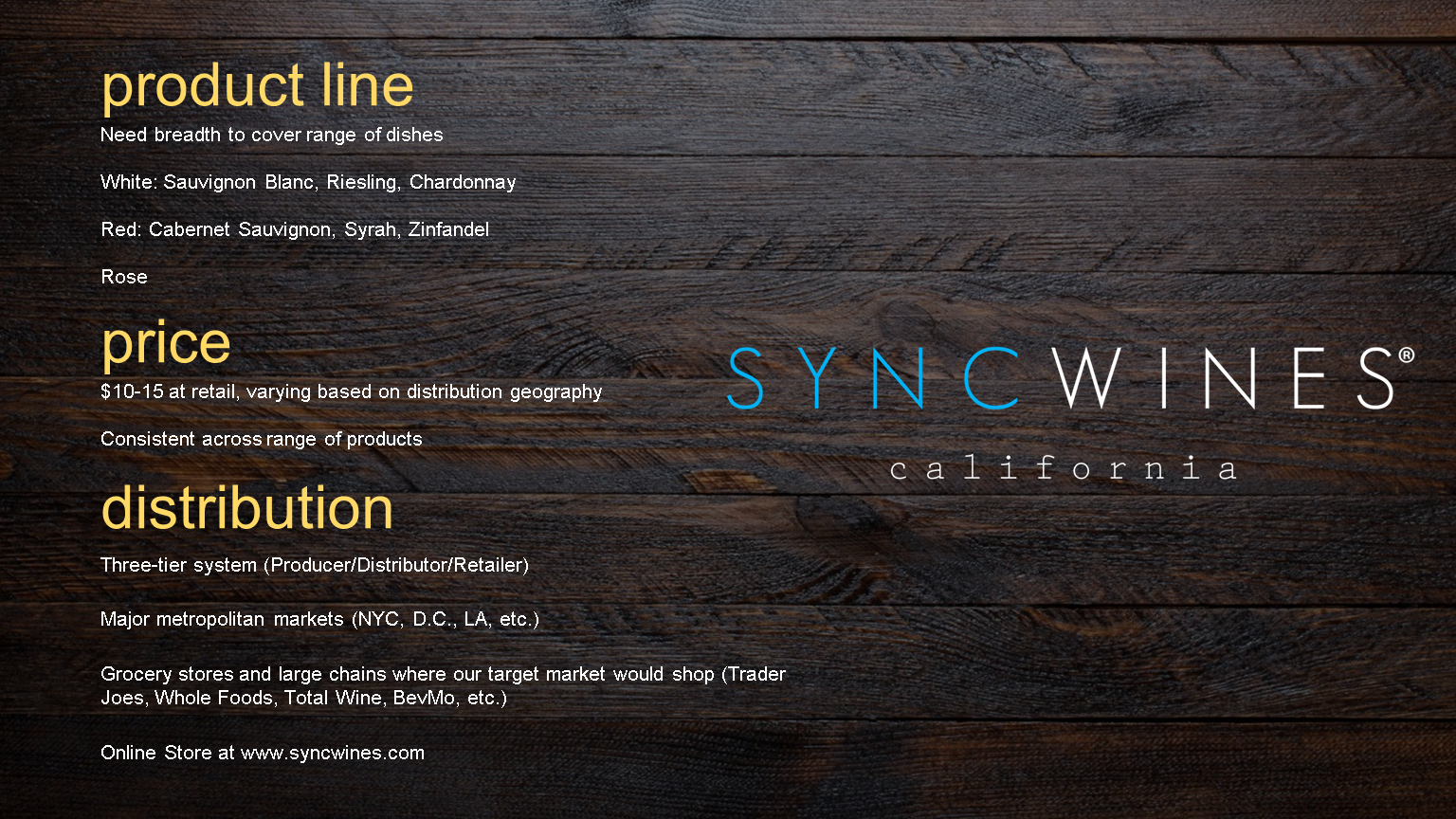
Sync: Product Description & Price
Product Line: Wines from California vineyards that are sold in simple packaging that clearly delineates what wine generally will match with what food. Sync will focus on matching foods on a broad level (BBQ with Zinfandel, spicy foods with Riesling, etc.) since the wine is for entry level drinkers, getting into specifics will overcomplicate the product. The more options Sync offers, the more options wine drinkers have for exploration which will keep them engaged and make them return customers.
Price: Sync can’t come across as cheap, but it needs to be priced to fit the “foodie” target. These aren’t collectors or people looking for exclusivity, but “foodies” also aren’t going to be drinking from a box. As mentioned previously, 79% of regular Millennial wine drinkers bought wines in the $10-$15 range (Teague) so Sync will be priced in that range.
Distribution: The alcohol industry is heavily regulated, and it has a complicated three-tier system that varies from state to state. Sync will be focused on high-population areas that fit the target ‘Millennial foodie’ market demographics. This local focus simplifies distribution. As the wine is food focused, Sync will be distributed primarily in grocery stores that the target market shops in including: Trader Joes, Whole Foods, Harris Teeter, etc. It will be important for Sync to have shelf space near the peripheries of the aisles, and outside of aisles near meat/produce sections. Sync will also be sold on the www.syncwines.com website which is in keeping with the buying habits of millennials.
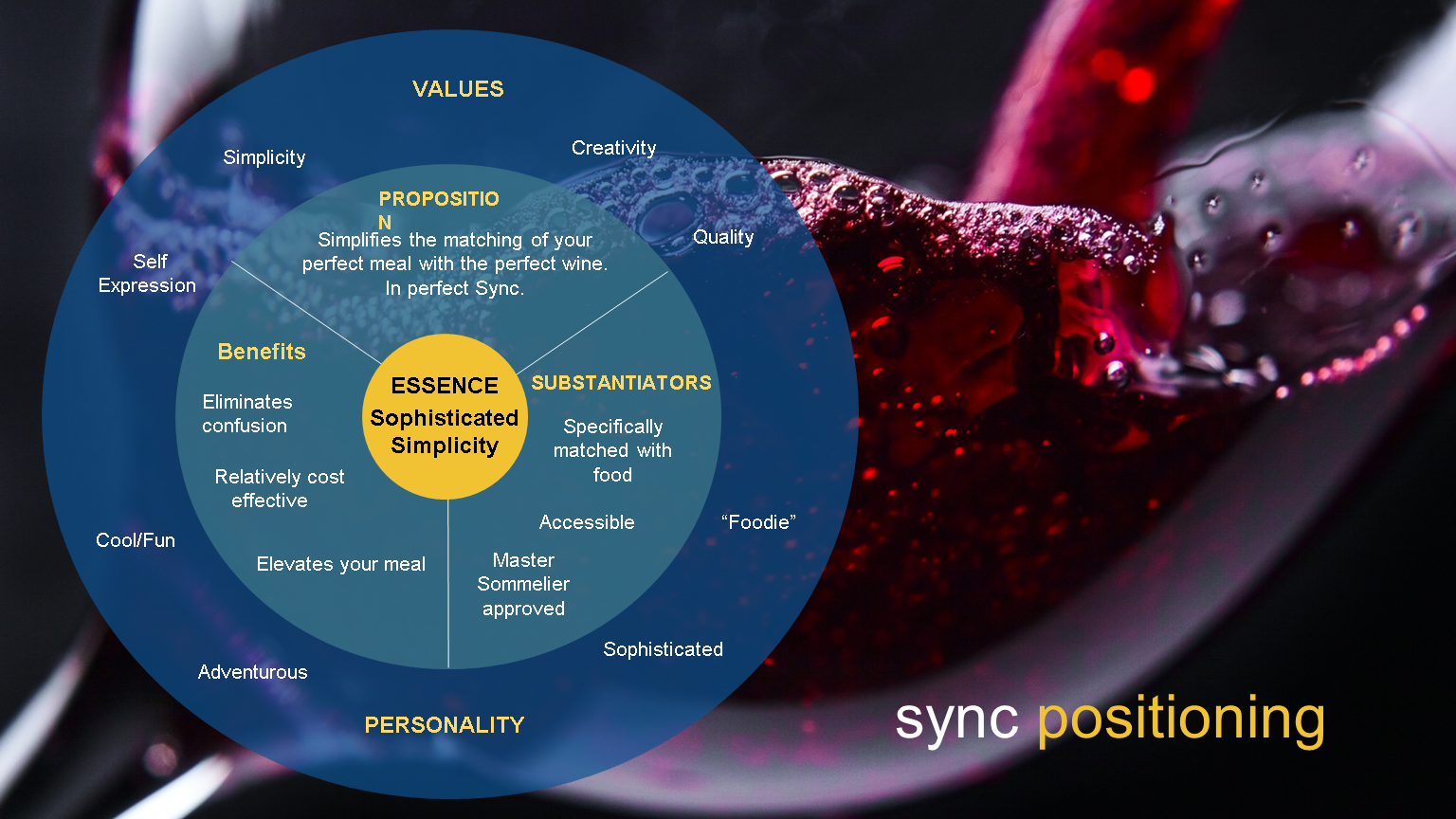
Sync: Positioning
● Competitive framework: Affordable wines for the target market - $10-15
● Target (demographic and attitudinal): Specifically targeted to millennials engrossed in the growing “foodie culture” that is emerging as a prevalent trend. These millennials are both male and female college educated urban professionals and college educated in the 18-34 age range (Teague). Being that the drinking age in the United States is 21, for purposes of marketing, Sync will only target the 21 - 34 age range.
● Sync is the best choice because: Sync is meant for the entry level “foodie” who wants to experiment with great wine with their great cuisine, and at an affordable price ($10-15 a bottle). There is a gap market for a wine brand that specifically stands out from the crowd to appeal to this new generation of young professionals with an increasingly discriminating palate. The brand’s core competency will be its ability to show the customer what wine will pair with their meal: You’ve just made a fantastic farm to table organic kobe beef slider with a quinoa kale salad….what should I pair it with?
● Sync’s target customer should believe this because: This brand’s family of wines have been selected and tested to sync with a number of cuisines to appeal to the most discriminating palate. These wines are the brainchild of Sync Wine’s team of world renowned Sommeliers who are masters of their craft. Customers of this brand of wine will know they have a quality product at a great price that will bode well with their next dish. Pick Sync.
● Brand character: The brand will be accessible yet aspirational. Cool, fun, modern, and authentic.

Wine Media Landscape is Changing
Previously, wine writers and reviewers for newspapers and publications like Wine Spectator, Wine Enthusiast and Food & Wine magazine were widely looked to for information on the latest and best wines on the market. Essentially, they were the gatekeepers of wine reviews and information. As Melissa Saunders, owner of wine importer Communal Brands put it: “Historically, wine has been marketed to older generations and came with a huge pretense. But this generation is blowing all of that out of the water. They don’t care about the pretentiousness of a wine, they want something that is authentic and speaks to them. This is a huge marketing opportunity.”
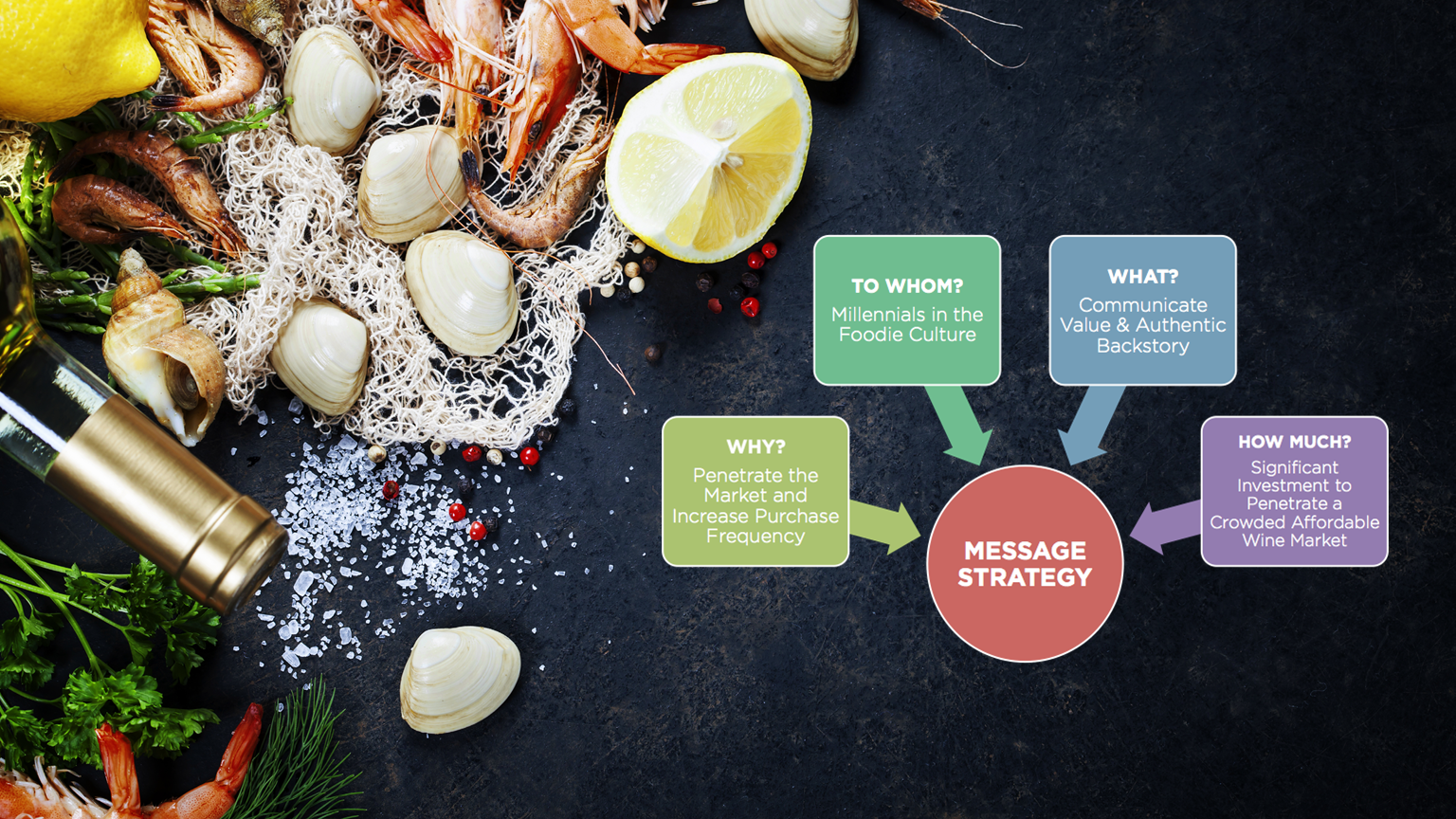
Sync Communications: Message Strategy
Why Is Sync Communicating: Sync is a new brand entering the market and must communicate its value to the targeted customers which are millennial foodies. The initial goal should be to achieve penetration in a crowded affordable wine market and once that is done, Sync must work to increase purchase frequency.
What Is Sync Trying to Convey: Sync must convey its value as the brand for millennial foodies as a good quality range of wines with convenient labelling that will save time and money. Sync must also convey a unique backstory to connect with millennial consumers and give them the authenticity that they crave.
To Whom Is Sync Communicating: Sync is communicating to millennials that are engrossed in the growing “foodie culture”. These millennials are both male and female college educated urban professionals and college educated in the 21-35 age range (Teague). These millennial foodies eat out often, but also like to experiment in the kitchen. They routinely spend a lot of money on exotic ingredients at places like Whole Foods, Trader Joe’s and local farmer’s markets. They often don’t have enough money leftover to spend on a high priced wine, but don’t want to ruin the taste of their food by picking the wrong wine. They are career-oriented individuals that fill their free time with extracurricular activities. They are generally liberal in their social views, active on social media and are more likely to watch television programming with an online streaming device rather than cable or network television.
How Much Should be Spent: In order to penetrate a crowded market, a significant percentage of revenue must be devoted to marketing in the beginning of Sync’s roll out.
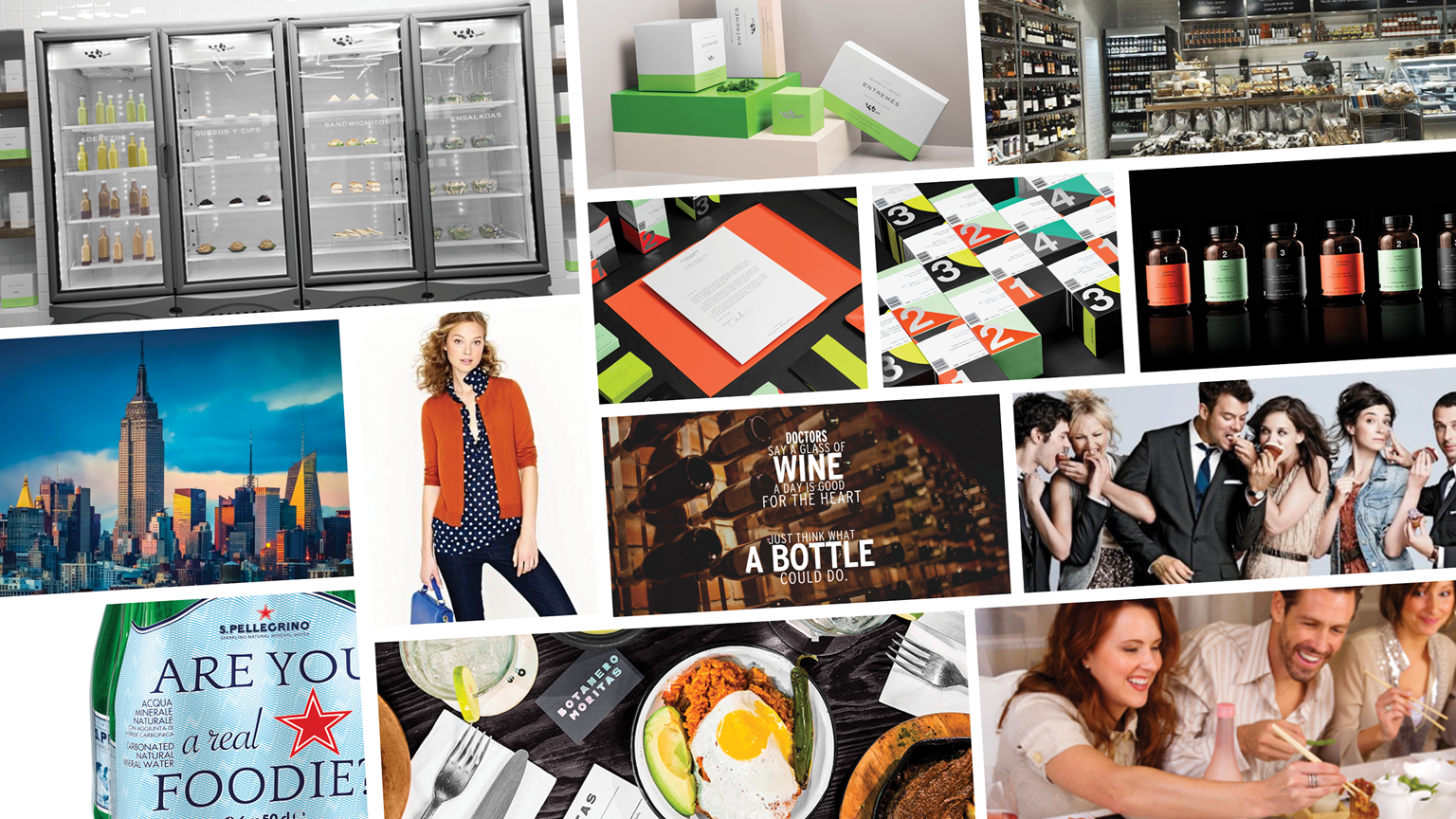
Sync Communications: Creative Strategy & Brand Personality
The original inspiration for the brand personality of Sync Wines included:
● Fun & Colorful
● Accessible yet aspirational
● Reflecting a contemporary lifestyle of the target market
● Strong emphasis on beautiful imagery of food associated with the product to align (or sync) the customers affinity for great cuisine for this new brand of wine
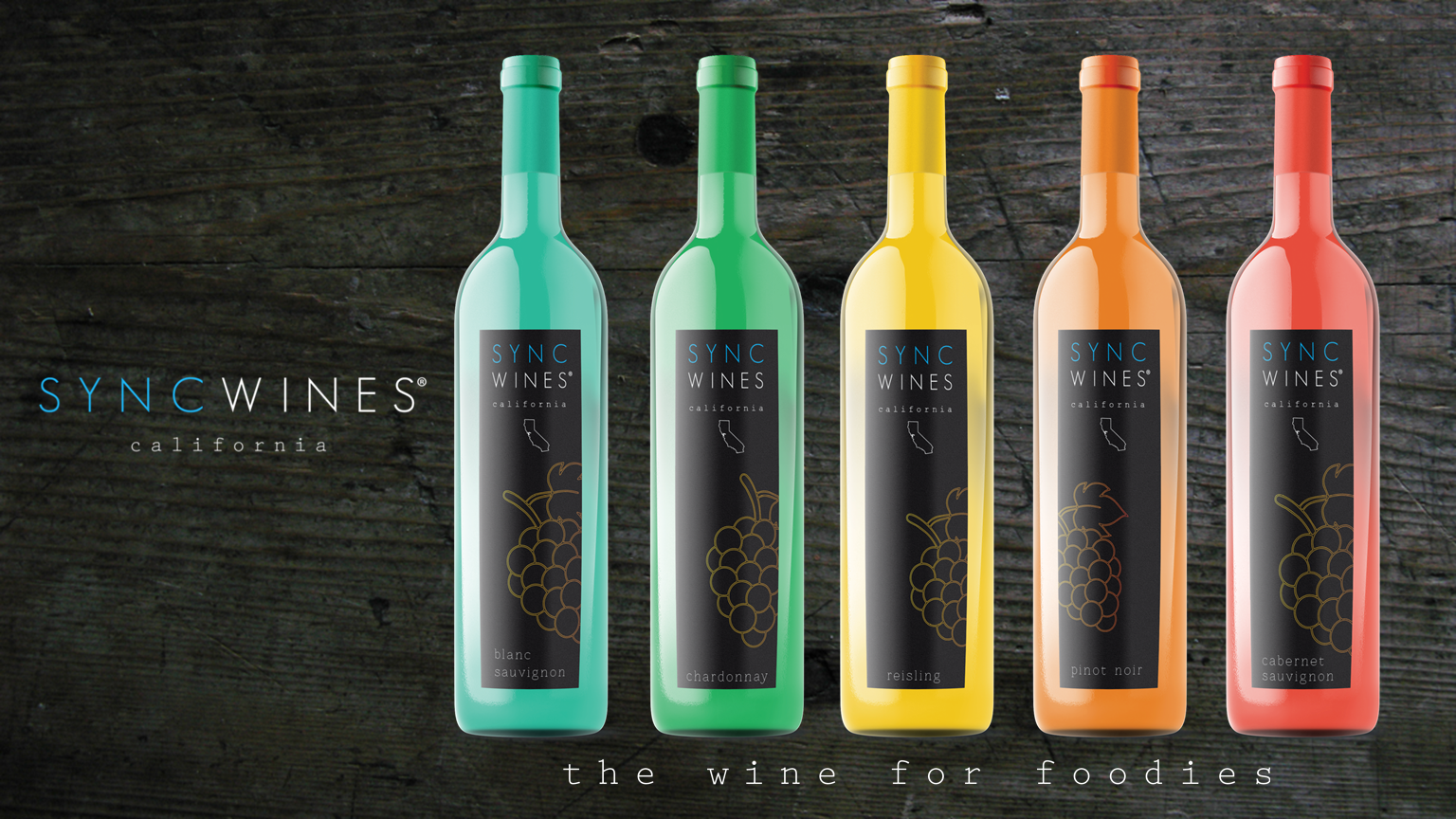
Sync Communications: Creative Strategy (Sync Wine)
Design: In a rabbit warren of non-descript wine brands in any given grocery store, the packaging design for Sync Wines will pop off the shelves with its decidedly bold, fun, and spirited design. The distinctive color of each bottle represents a particular wine varietal and signals the taste profile along the “Sync Spectrum” (discussed later).
Brand Tagline: The tagline for the brand will be “the wine for foodies” to attract a customer with an affinity for fine cuisine and are in need for a fine wine to match. The brand lies on the intersections of approachable, sophisticated, competent and young. “No one was ever fired for choosing IBM” - a similar mantra will be at the heart of the Sync Wines brand.
Authentic Story: Sync Wines will be sourced directly from their vineyards in California - strategically selected for its prime location and storied wine industry. Sync Wines also wanted to make transparent the origin of its wines to add to the overall narrative to the brand. The mark of California will be added to the logo to endorse this need for transparency.
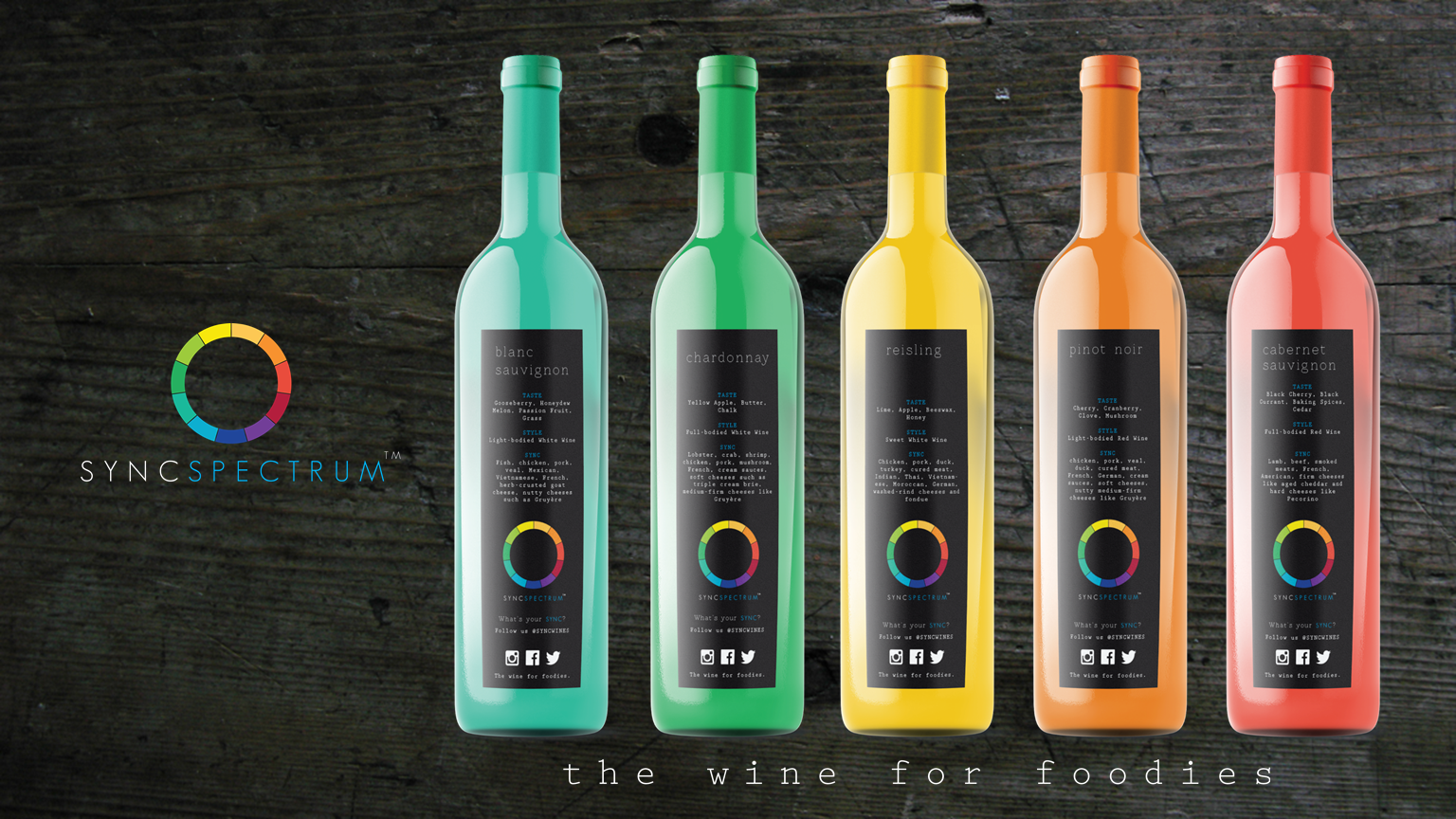
Sync Communications: Creative Strategy (The Sync Spectrum)
he Sync Spectrum: The hallmark to the Sync Wines brand will be the company’s proprietary “Sync Spectrum” that will allow customers to easily “sync” their favorite dish to the taste profile of any particular wine in the line.
Reason to Believe
The Sync Spectrum was developed developed by a group of world renowned chefs and Master Sommeliers that have learned the fine art of food and wine pairings that will appeal to even the most discriminating foodie customer.
Each wine bottle will pop off the shelf with a bold color that is matched to a color along the Sync Spectrum for ease of use. Colors along the cool spectrum are denoted as white wines ranging from light to full bodied while the warm colors along the spectrum relate to light to full bodied reds. Only the most popular varietals will be offered initially. More varietals can be offered as the brand expands, as the Sync Spectrum is infinite in its nature.
We will invite the customer to visit our digital media assets to share their experience with brand online and learn more about the Sync Spectrum and why Sync Wine is truly “the wine for foodies.”
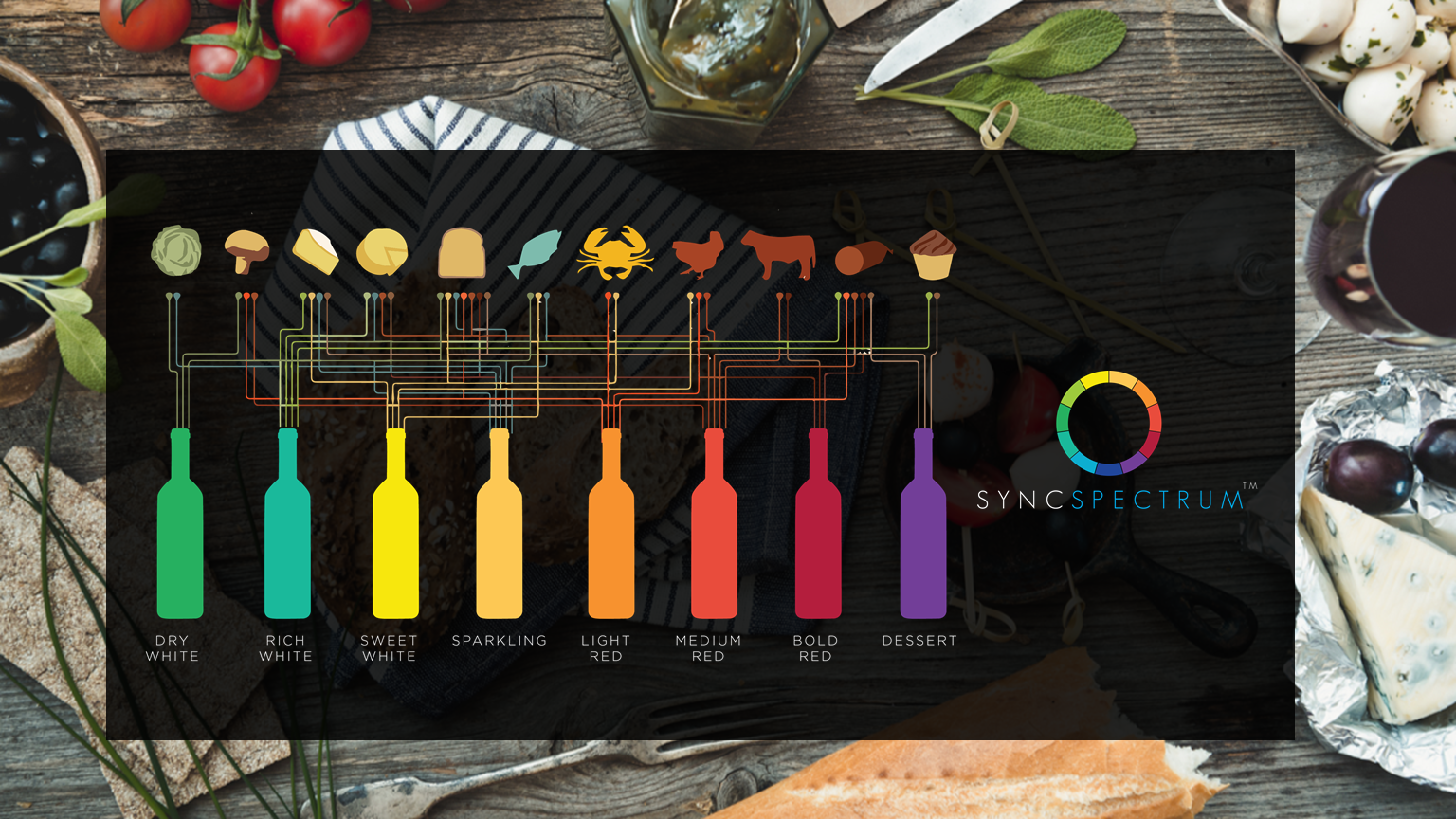
Sync Communications: Creative Strategy (The Sync Spectrum)
The syncspectrum will be a mainstay on syncwines.com where customers can learn more about the tried and true sync technology with Sync Wine’s variety of wines.
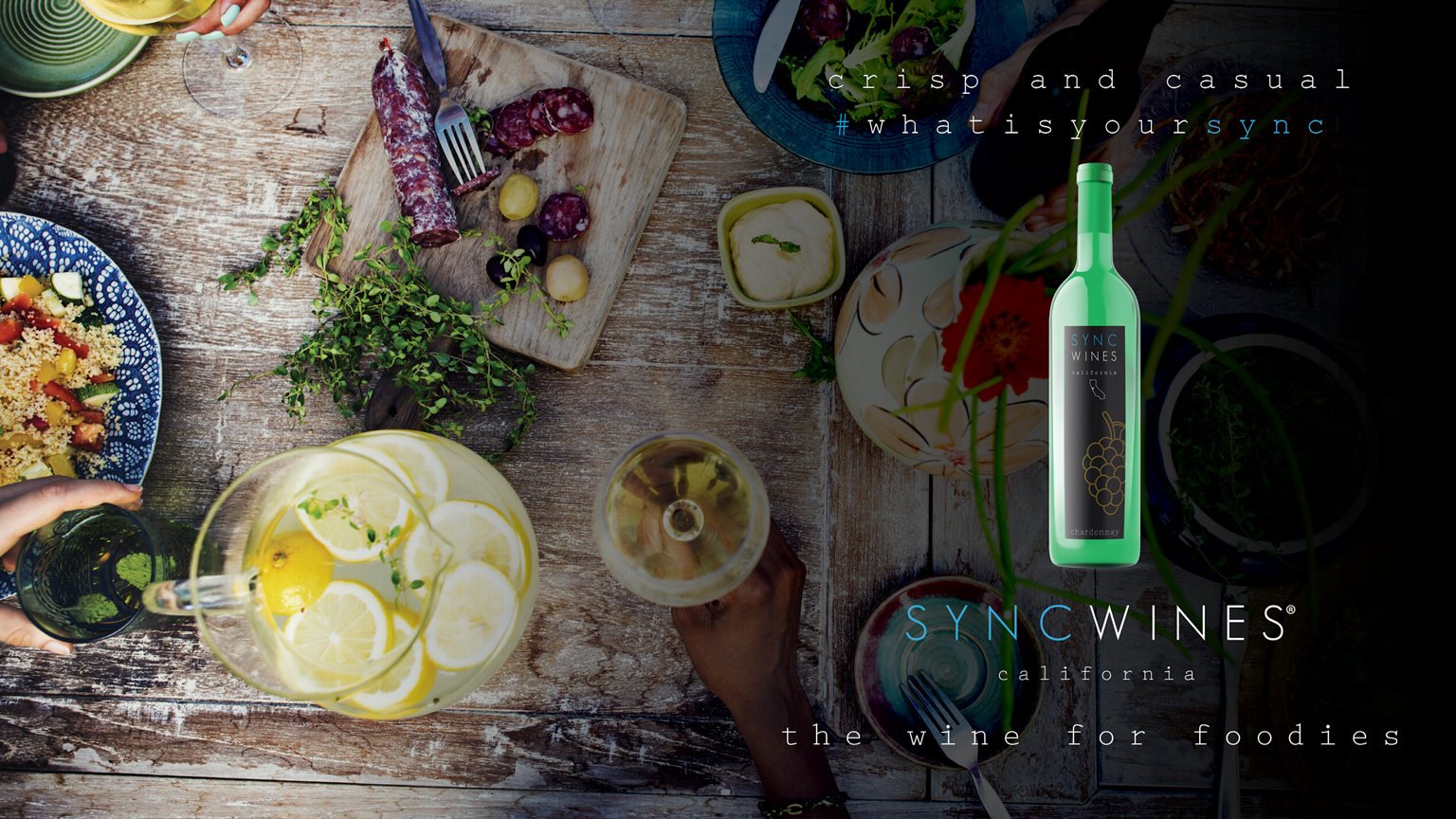
Sync Communications: Creative Strategy (Print & Web)
The aesthetic of the the creative in print and web will be sophisticated and fun in its execution. There will be a constant reinforcement of great food with the suggestion of pairing it with one of Sync Wines’ varietals. The call to action: “What is your Sync?” asks the customer to engage with the brand online.
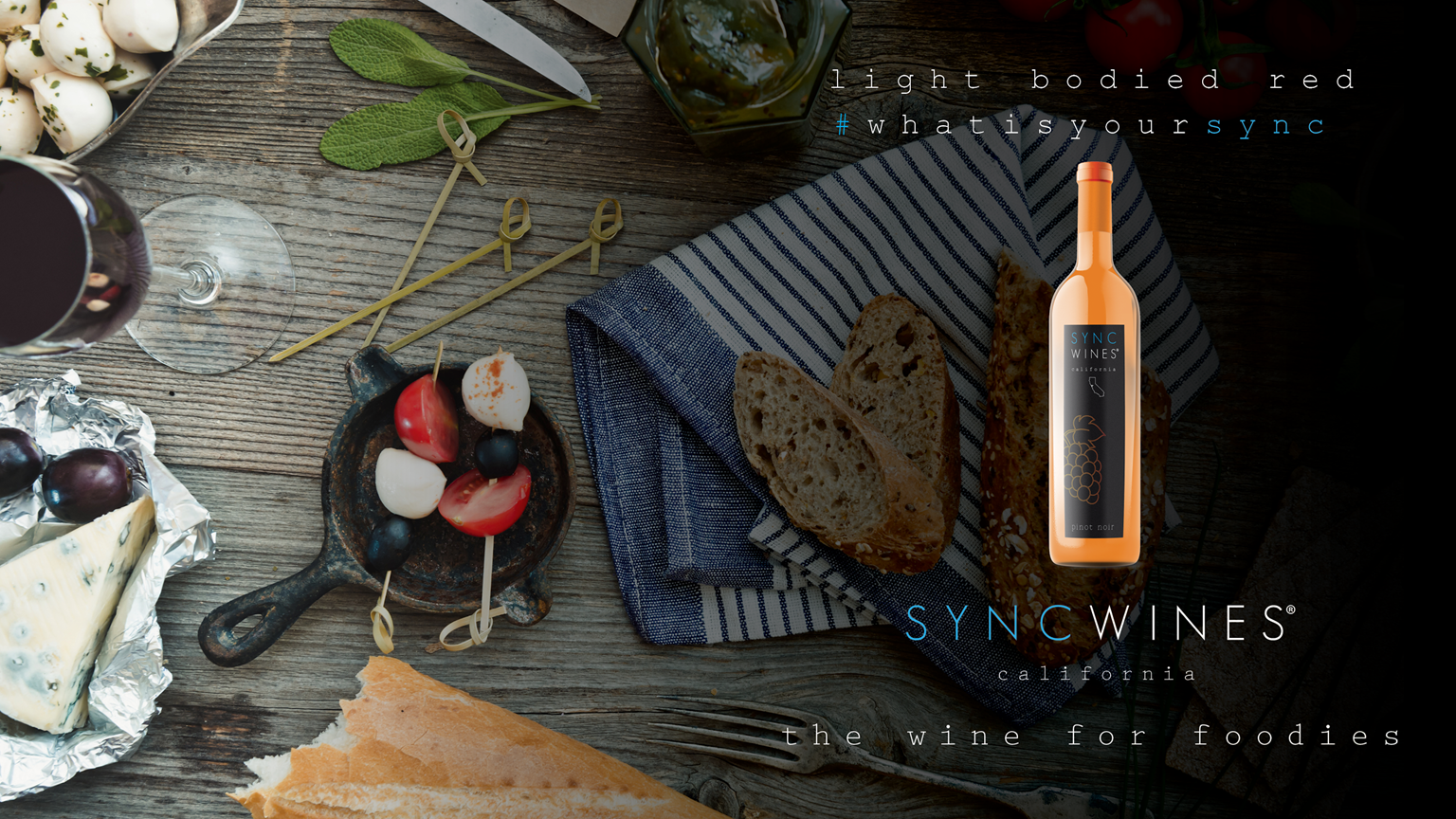

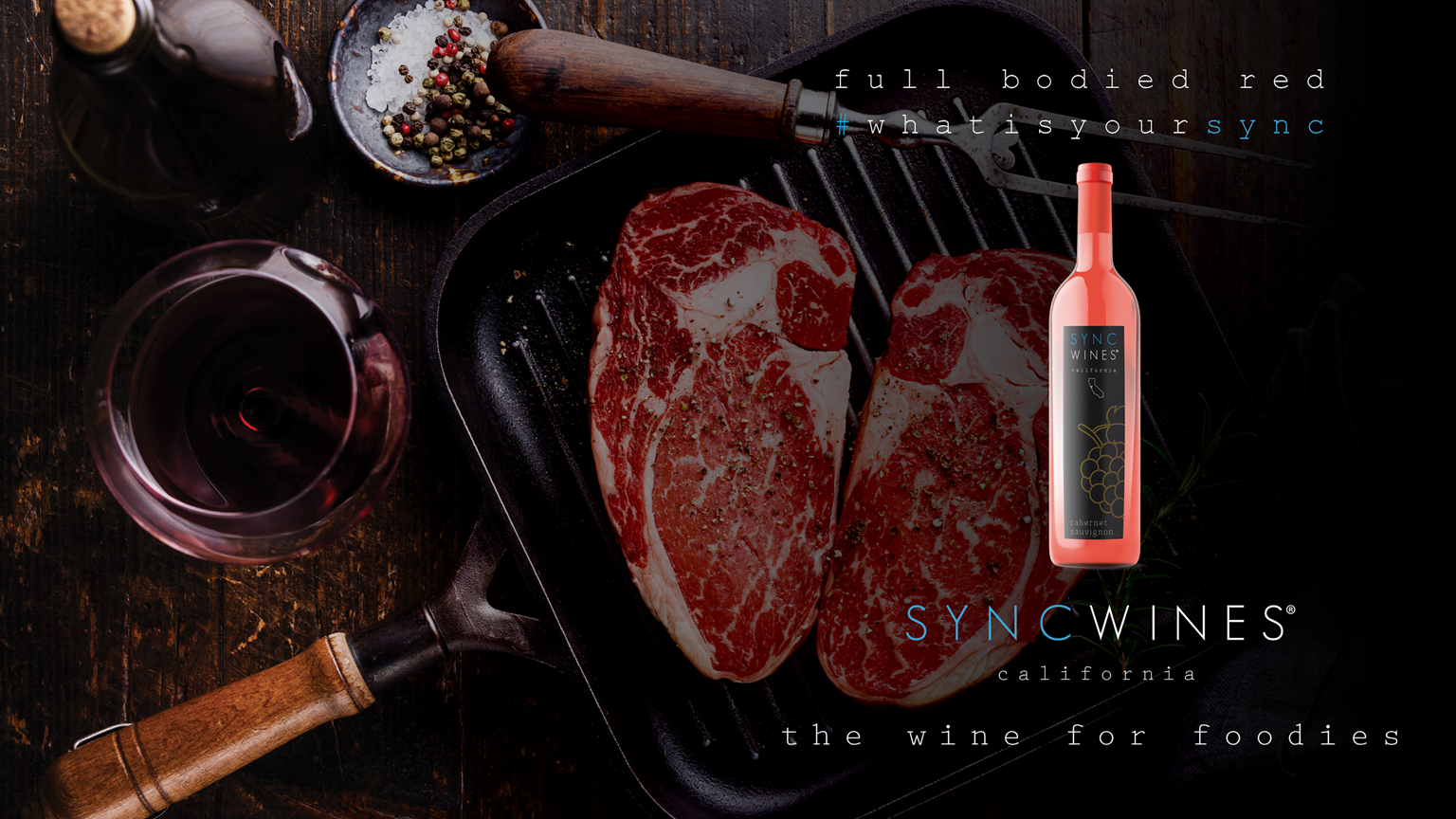
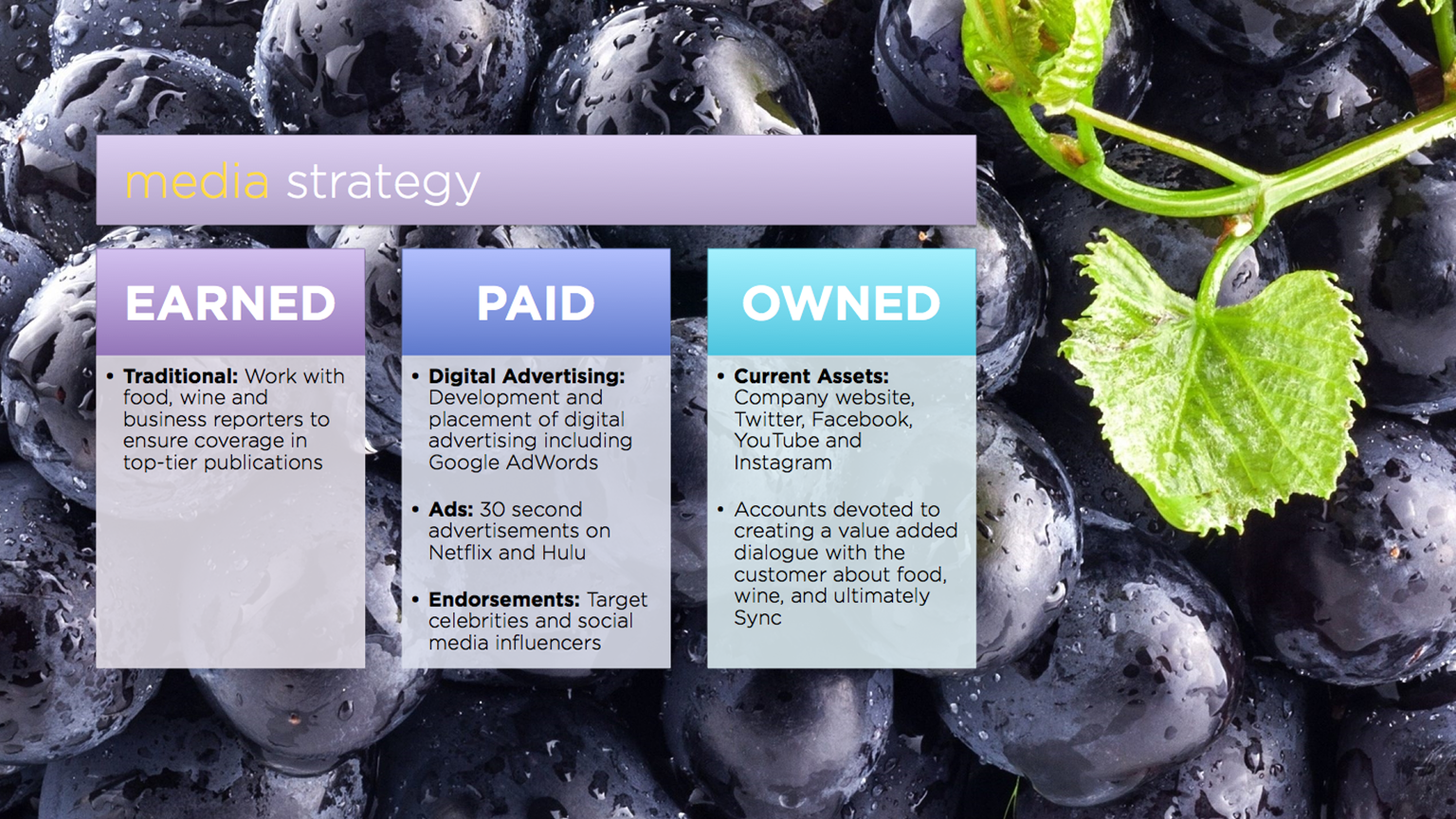
Sync Communications: Media Strategy (Earned, Paid, Owned)
Brands can no longer purchase a 30-second ad on the nightly news and expect to move their products off the shelves. A brand communications strategy needs to be an integrated, multi-channel rollout that includes earned, social, paid, and owned.
Earned: Sync will work closely with top-tier food, wine and business reporters, as well as those from trade publications. Ahead of the product launch, Sync representatives will meet reporters to walk them through the new item and explain why it will be popular among our target consumers. These meetings will allow reporters to see our product first hand and sample. The reporters will be given permission to publish first immediately after the embargo lifts early at midnight on launch day. This outreach will increase the likelihood that they will write about the product when it is launched. While millennials are turning away from conventional marketing as mentioned previously, a complete communications strategy should not ignore this traditional earned media at publications such as the NY Times, USA Today, Washington Post, LA Times, Advertising Age, Ad Week, Wine Enthusiast, Food & Wine. Buzz amongst the food and wine community could bolster and be used in conjunction with the more non-traditional communications efforts
Paid: A good amount of the paid budget will go toward digital advertising discussed in the next section. Because Sync is geared toward millennials, it must be creative, because they are a much more discerning consumer when it comes to advertisements (Schwabel). Sync will also be searching for celebrity endorsers that resonate with our target demographic. These advertisements and endorsements will be placed on Sync’s owned media platforms and on online streaming devices such as Hulu. Recent studies show that millennials are increasingly turning to online streaming to watch television programming (Lynch). A good example of a potential celebrity endorser would be Aziz Ansari, a millennial himself, who came up through a sitcom (“Parks and Recreation” which is still featured heavily on Hulu) and just launched a critically acclaimed show (“Master of None”) on Netflix that deals exclusively with what it is like to be a millennial.
Owned: Sync will make full use of its owned assets, and create new ones to get the word out. In addition to our company website, Sync will have Twitter, Facebook, Youtube, and Instagram accounts devoted solely to sharing information about Sync.

Sync Communications: Media Strategy (Social)
Advertising: Sync will be advertised heavily on Facebook, Twitter, and Instagram, as well as through Google ads. These advertisements will be heavily targeted to users who are interested in foodie culture, wine, and in geographic locations that stock our product. In addition to click-grabbing headline advertisements through Google ads, Sync will also be displayed in Google searches to direct users who are searching for terms like “wine pairing”. Using previously captured email addresses, Sync news and special deals will be shared with enthusiastic followers.
Influencers: In addition to our outreach to traditional media, Sync’s media outreach will focus on blogs. This is very important a large number of millennials rely mostly on blogs for information on potential purchases (Schwabel). Heavy outreach to “foodie” social media influencers on Twitter, Facebook and Instagram will be included in order to increase the discussion about Sync and increase the reach of the brand name, story and idea. With all of our social outreach, we will direct consumers to our site and try to capture email addresses for future email outreach. This outreach will include some paid promotional opportunities with social media influencers that have large followings within the target market.
Wine Apps: More and more wine drinkers, particularly millennials are turning to wine apps to log their bottles of wine, research, read reviews and discover new wines. These apps include but are not limited to Vivino and Delectable which all the user to collect and share information on the brands they drink. A strong presence on these apps with consistent reviews is essential.
Original Content: Social outreach won’t simply be an addition to our other media efforts. It is integral to reaching our target audience. Weeks ahead of the official launch, Sync’s Facebook, YouTube, Instagram, and Twitter accounts will feature a short video of millennials passionately discussing their love of creating their own meals, and their struggles to pair wine for their guests. It will end with a silhouette of the new product with text that says: Change is Coming for Foodies.
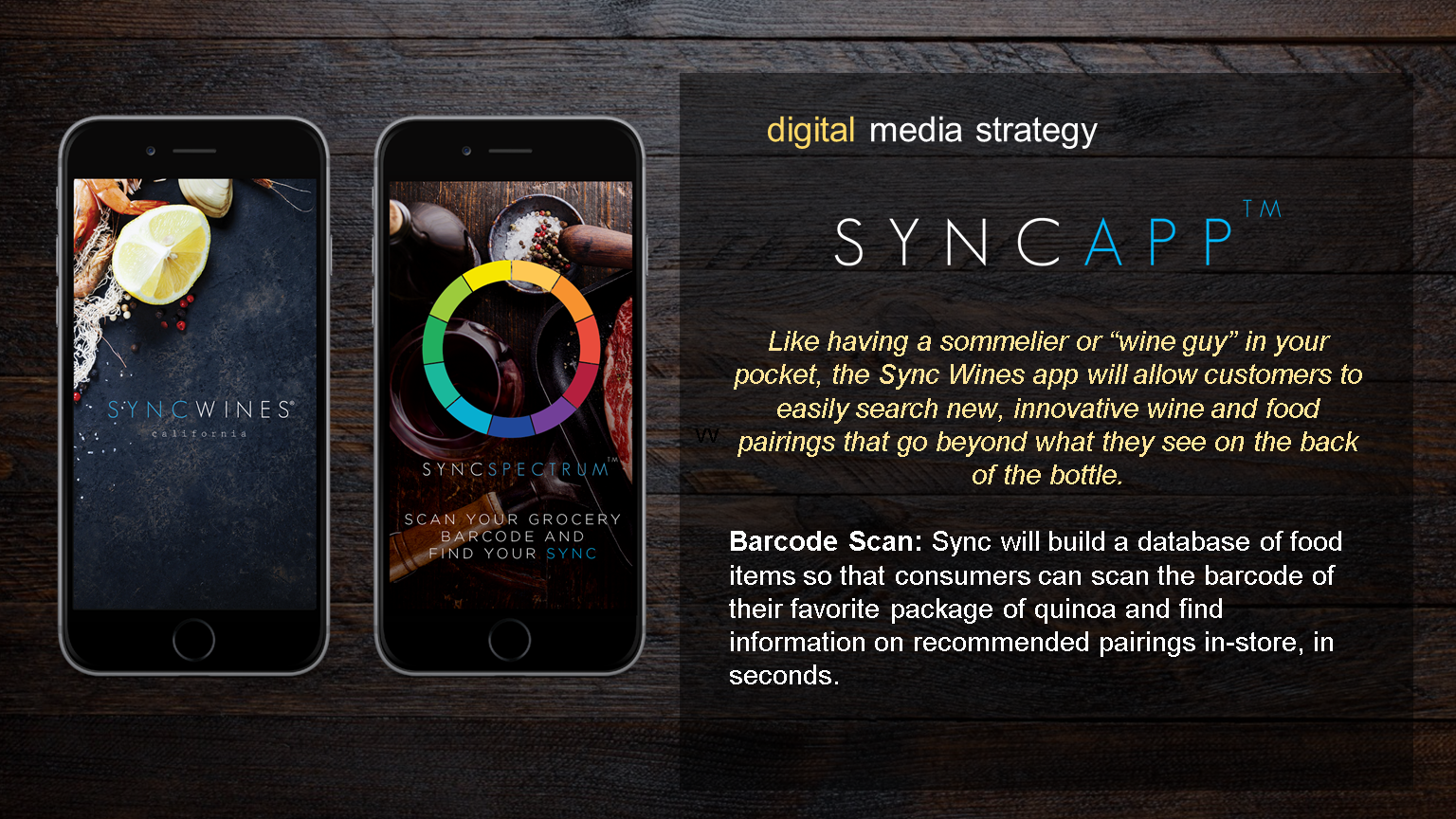
Sync Communications: Media Strategy (Native App)
The purpose of a stand alone “Sync Wines” app for smartphones is for customers to feel as if they have a sommelier or wine retailer in their pocket. The Sync Wine App will allow customers to easily search new and innovative wine and food pairings that go beyond the pairings that are advertised on the back of the Sync Wines bottles. Additionally, the Sync app will feature a barcode scanning option. The Sync app will quickly build a database of food items (starting at the targeted Whole Foods and Trader Joe’s) so that consumers can scan the barcode of their favorite package of food and find information on recommended pairings in-store, in seconds.
Millennials are avid consumers of information on their smartphones. According to Nielson, they are the largest segment of smartphone owners. In the second quarter of 2014, 85% of millennials aged 18-24 owned smartphones and 86% of 25-34 year olds which represents an increase from 77% and 80% respectively, in the same period of 2013 (Mobile Millennials).
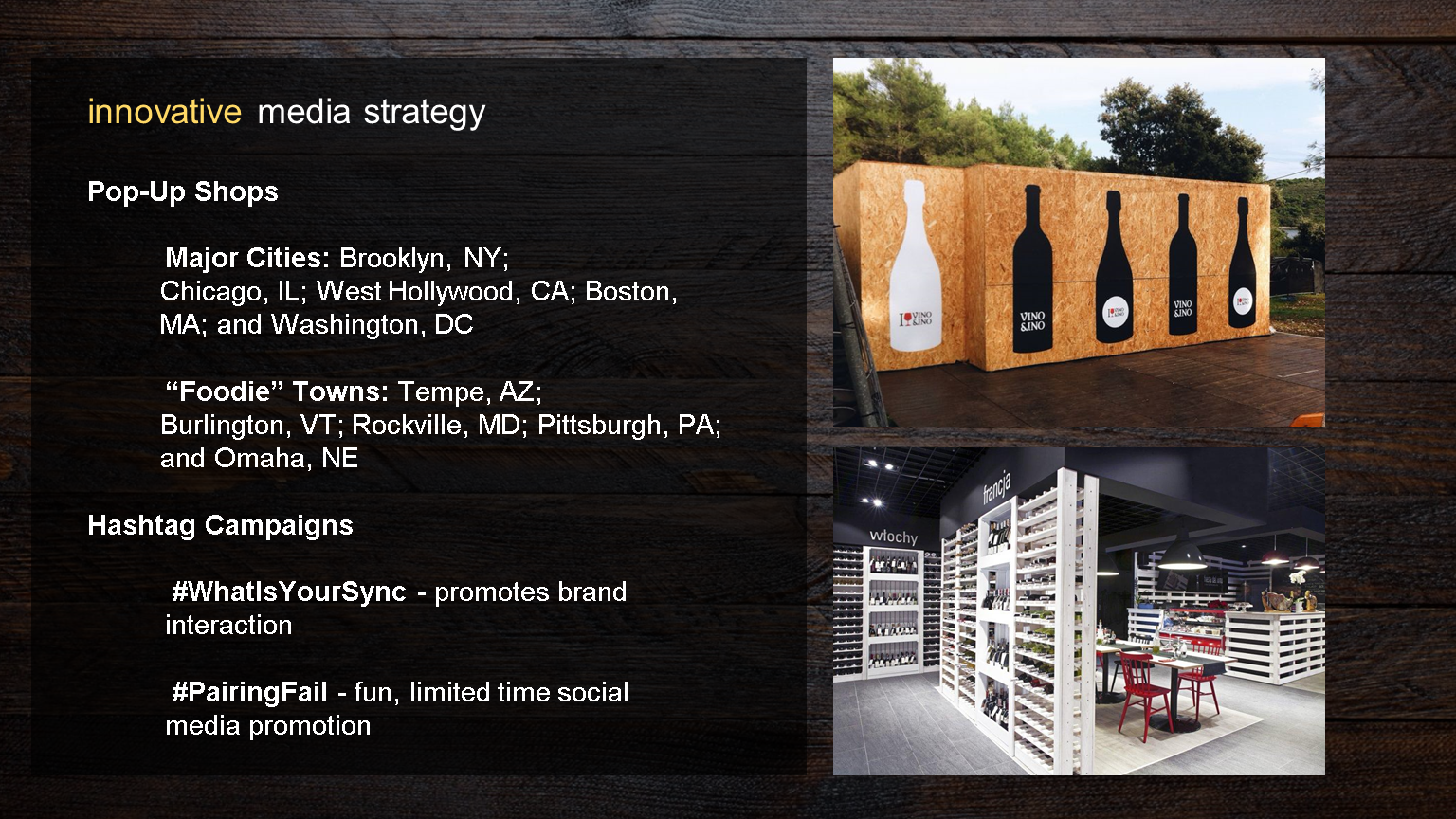
Sync Communications: Media Strategy (Innovative Ideas)
Pop-Up Shops: Sync will experiment with pop-up shops in major metro areas across the country with heavy foot traffic (such as: Brooklyn, NY; Chicago, IL; West Hollywood, CA; Boston, MA; and Washington, DC) and established “foodie” towns including places such as: Tempe, AZ; Burlington, VT; Rockville, MD; Pittsburgh, PA; and Omaha, NE (Livability). The pop-up shops will include samples for those passing by, giant replica bottles that will showcase our new labels and partnerships with local independent food establishments or farmers markets. The pop-up shops will be combined with social outreach to direct consumers to the Sync website to capture email addresses for further outreach and encourage purchases.
Hashtag Campaigns: The main marketing hashtag for Sync Wines will be #WhatIsYourSync. This is intended to encourage consumers to interact with the brand by sending in photos of their meals using Sync Wines and the suggested pairings. Sync will also launch a limited campaign that encourages foodies to share on social platforms their worst experiences with pairing food and wine. They will use the hashtag #PairingFail. They will not be encouraged to use #SyncFail, because “Sync” must stay positive in consumers minds and only reflect good pairings of food and wine.

